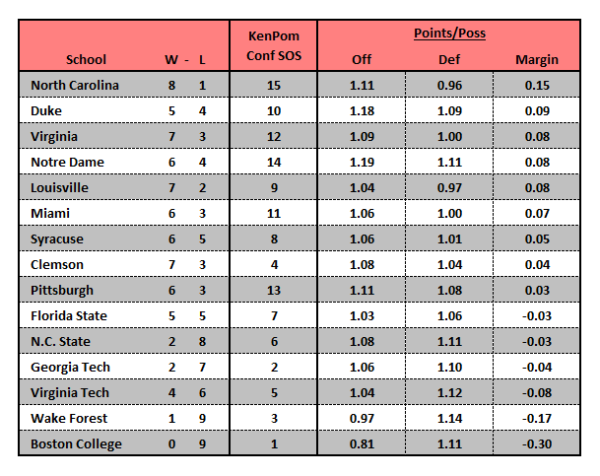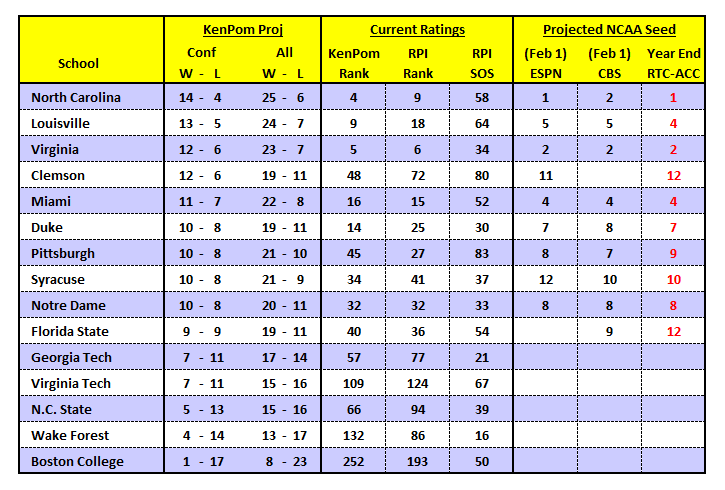Inside The ACC Numbers: Volume II
Posted by Brad Jenkins (@bradjenk) on February 5th, 2016Here is the latest edition of our weekly look at the current ACC standings and team performances, focusing on which teams are playing better or worse than their records indicate. Each week we also delve into some advanced metrics to find a few interesting teams or player stats and trends. This week we examine home court advantage within the league. Finally, we will forecast how the final standings may look and what that means for ACC schools’ postseason aspirations.
Note: All numbers are current for games played through Wednesday, February 3rd.
Current Standings Despite Monday night’s defeat at Louisville, North Carolina is still the ACC’s best team in both the standings and in points per possession (PPP) margin. Interestingly, even though much has been made of Duke’s struggles (the Blue Devils are currently in eighth place), it has outperformed every team but one above them in the standings. It appears that Mike Krzyzewski’s team’s inability to win the close ones is the real issue that must be fixed — Duke has lost all three of its contests that were decided by five points or fewer. Conversely, Clemson and Pittsburgh have each benefited by winning all three of their five-point or fewer margin games. Looking further down the standings, we see that N.C. State and Georgia Tech have basically performed at a level equal to Florida State and better than Virginia Tech, but they trail both of those teams in the current standings by at least two games. Heading into the back nine of conference play, future opponents should consider themselves warned — the Wolfpack and Yellow Jackets may barely rank above the likes of Wake Forest and Boston College in the standings, but they are both significantly better than the leagues’ worst two teams.
Despite Monday night’s defeat at Louisville, North Carolina is still the ACC’s best team in both the standings and in points per possession (PPP) margin. Interestingly, even though much has been made of Duke’s struggles (the Blue Devils are currently in eighth place), it has outperformed every team but one above them in the standings. It appears that Mike Krzyzewski’s team’s inability to win the close ones is the real issue that must be fixed — Duke has lost all three of its contests that were decided by five points or fewer. Conversely, Clemson and Pittsburgh have each benefited by winning all three of their five-point or fewer margin games. Looking further down the standings, we see that N.C. State and Georgia Tech have basically performed at a level equal to Florida State and better than Virginia Tech, but they trail both of those teams in the current standings by at least two games. Heading into the back nine of conference play, future opponents should consider themselves warned — the Wolfpack and Yellow Jackets may barely rank above the likes of Wake Forest and Boston College in the standings, but they are both significantly better than the leagues’ worst two teams.
Without Boston College We have decided to make this a weekly chart. Don’t take this as a slap at Jim Christian’s team, but Boston College is so far below the rest of the ACC in talent that it makes sense to discount its games to fairly evaluate the rest of the league. For instance, Notre Dame has used two blowouts over the Eagles to artificially boost itself in the standings and in points per possession efficiency. That’s obviously a huge advantage over the schools that have yet to play Boston College. Clemson gets the same edge over the back half of league play, with two meetings against the Eagles still to come.
We have decided to make this a weekly chart. Don’t take this as a slap at Jim Christian’s team, but Boston College is so far below the rest of the ACC in talent that it makes sense to discount its games to fairly evaluate the rest of the league. For instance, Notre Dame has used two blowouts over the Eagles to artificially boost itself in the standings and in points per possession efficiency. That’s obviously a huge advantage over the schools that have yet to play Boston College. Clemson gets the same edge over the back half of league play, with two meetings against the Eagles still to come.
Advanced Stat of the Week: Home Court Advantage Miami gets the most credit for this in-depth look at home court advantage, as we’ve all noticed a pattern of extreme performances by the Hurricanes over the last couple of weeks — impressive play in a home win over Duke; getting worked by N.C. State in Raleigh; administering a beating to Notre Dame in Coral Gables. But is Miami’s Jekyll-and-Hyde syndrome between home and the road the norm? It turns out that while the Hurricanes have the largest variance between playing at home and on the road, they are not the only ACC team with a big difference. For some schools like Pittsburgh, Virginia and Virginia Tech, it is the offense that performs much worse when traveling — each of those three teams scores at least 0.12 points per possession more in their home gyms. But for others like Miami, Notre Dame and Louisville, their defenses become much more generous on road trips.
Miami gets the most credit for this in-depth look at home court advantage, as we’ve all noticed a pattern of extreme performances by the Hurricanes over the last couple of weeks — impressive play in a home win over Duke; getting worked by N.C. State in Raleigh; administering a beating to Notre Dame in Coral Gables. But is Miami’s Jekyll-and-Hyde syndrome between home and the road the norm? It turns out that while the Hurricanes have the largest variance between playing at home and on the road, they are not the only ACC team with a big difference. For some schools like Pittsburgh, Virginia and Virginia Tech, it is the offense that performs much worse when traveling — each of those three teams scores at least 0.12 points per possession more in their home gyms. But for others like Miami, Notre Dame and Louisville, their defenses become much more generous on road trips.
Despite the gaudy reputation of Cameron Indoor Stadium, Duke has not seen any home versus road difference on either end of the floor. It’s worth noting that even though the Blue Devils are tied with North Carolina for the league’s best efficiency in road trips, Duke’s numbers are somewhat skewed by easily handling ACC bottom dwellers Boston College and Wake Forest. Perhaps the ACC should check the baskets at PNC Arena in Raleigh for proper circumference, though. Both N.C. State and its opponents score at will in Raleigh but struggle to do so elsewhere. So far this season, ACC home teams have won 64 percent of league games, which ranks ninth highest among the nation’s 32 conferences. This is the third year of a 15-team ACC, and maybe this is a product of the old members getting used to the new additions — home teams only won 56 percent of games last season and 57 percent the year before. This season’s league average margin of 0.10 points per possession equates to about seven points a game which is above the standard 3-to-5 point home court edge built into most point spreads.
Future Forecast The above chart gives us a predicted order of finish with final regular season records based on KenPom’s current win probabilities for each team. Also included are a few comparative rankings that are mentioned frequently when evaluating NCAA Tournament potential, as well as projections from two bracketology experts, ESPN‘s Joe Lunardi and CBS Sports‘ Jerry Palm. Note that while they project as if the field was named tomorrow, we make our projections based on final KenPom projected records. For example, we included Clemson and Florida State even though each has some resume flaws. The Tigers need to continue to impress in league action because they did nothing helpful in non-conference play, and the Seminoles probably can’t afford to slip below .500 in ACC play. We also kept North Carolina as a #1 seed despite now projecting as a six-loss team, but to earn that spot the Tar Heels may have to win the ACC Tournament as well as the regular season title.
The above chart gives us a predicted order of finish with final regular season records based on KenPom’s current win probabilities for each team. Also included are a few comparative rankings that are mentioned frequently when evaluating NCAA Tournament potential, as well as projections from two bracketology experts, ESPN‘s Joe Lunardi and CBS Sports‘ Jerry Palm. Note that while they project as if the field was named tomorrow, we make our projections based on final KenPom projected records. For example, we included Clemson and Florida State even though each has some resume flaws. The Tigers need to continue to impress in league action because they did nothing helpful in non-conference play, and the Seminoles probably can’t afford to slip below .500 in ACC play. We also kept North Carolina as a #1 seed despite now projecting as a six-loss team, but to earn that spot the Tar Heels may have to win the ACC Tournament as well as the regular season title.










































